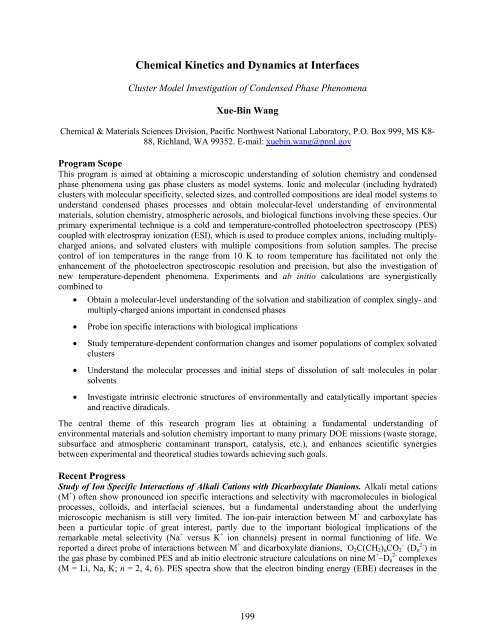Eighth Condensed Phase and Interfacial Molecular Science (CPIMS)
Eighth Condensed Phase and Interfacial Molecular Science (CPIMS)
Eighth Condensed Phase and Interfacial Molecular Science (CPIMS)
Create successful ePaper yourself
Turn your PDF publications into a flip-book with our unique Google optimized e-Paper software.
Chemical Kinetics <strong>and</strong> Dynamics at Interfaces<br />
Cluster Model Investigation of <strong>Condensed</strong> <strong>Phase</strong> Phenomena<br />
Xue-Bin Wang<br />
Chemical & Materials <strong>Science</strong>s Division, Pacific Northwest National Laboratory, P.O. Box 999, MS K8-<br />
88, Richl<strong>and</strong>, WA 99352. E-mail: xuebin.wang@pnnl.gov<br />
Program Scope<br />
This program is aimed at obtaining a microscopic underst<strong>and</strong>ing of solution chemistry <strong>and</strong> condensed<br />
phase phenomena using gas phase clusters as model systems. Ionic <strong>and</strong> molecular (including hydrated)<br />
clusters with molecular specificity, selected sizes, <strong>and</strong> controlled compositions are ideal model systems to<br />
underst<strong>and</strong> condensed phases processes <strong>and</strong> obtain molecular-level underst<strong>and</strong>ing of environmental<br />
materials, solution chemistry, atmospheric aerosols, <strong>and</strong> biological functions involving these species. Our<br />
primary experimental technique is a cold <strong>and</strong> temperature-controlled photoelectron spectroscopy (PES)<br />
coupled with electrospray ionization (ESI), which is used to produce complex anions, including multiplycharged<br />
anions, <strong>and</strong> solvated clusters with multiple compositions from solution samples. The precise<br />
control of ion temperatures in the range from 10 K to room temperature has facilitated not only the<br />
enhancement of the photoelectron spectroscopic resolution <strong>and</strong> precision, but also the investigation of<br />
new temperature-dependent phenomena. Experiments <strong>and</strong> ab initio calculations are synergistically<br />
combined to<br />
• Obtain a molecular-level underst<strong>and</strong>ing of the solvation <strong>and</strong> stabilization of complex singly- <strong>and</strong><br />
multiply-charged anions important in condensed phases<br />
• Probe ion specific interactions with biological implications<br />
• Study temperature-dependent conformation changes <strong>and</strong> isomer populations of complex solvated<br />
clusters<br />
• Underst<strong>and</strong> the molecular processes <strong>and</strong> initial steps of dissolution of salt molecules in polar<br />
solvents<br />
• Investigate intrinsic electronic structures of environmentally <strong>and</strong> catalytically important species<br />
<strong>and</strong> reactive diradicals.<br />
The central theme of this research program lies at obtaining a fundamental underst<strong>and</strong>ing of<br />
environmental materials <strong>and</strong> solution chemistry important to many primary DOE missions (waste storage,<br />
subsurface <strong>and</strong> atmospheric contaminant transport, catalysis, etc.), <strong>and</strong> enhances scientific synergies<br />
between experimental <strong>and</strong> theoretical studies towards achieving such goals.<br />
Recent Progress<br />
Study of Ion Specific Interactions of Alkali Cations with Dicarboxylate Dianions. Alkali metal cations<br />
(M + ) often show pronounced ion specific interactions <strong>and</strong> selectivity with macromolecules in biological<br />
processes, colloids, <strong>and</strong> interfacial sciences, but a fundamental underst<strong>and</strong>ing about the underlying<br />
microscopic mechanism is still very limited. The ion-pair interaction between M + <strong>and</strong> carboxylate has<br />
been a particular topic of great interest, partly due to the important biological implications of the<br />
remarkable metal selectivity (Na + versus K + ion channels) present in normal functioning of life. We<br />
reported a direct probe of interactions between M + <strong>and</strong> dicarboxylate dianions, – O2C(CH2)nCO2 – (Dn 2- ) in<br />
the gas phase by combined PES <strong>and</strong> ab initio electronic structure calculations on nine M + –Dn 2- complexes<br />
(M = Li, Na, K; n = 2, 4, 6). PES spectra show that the electron binding energy (EBE) decreases in the<br />
199
















